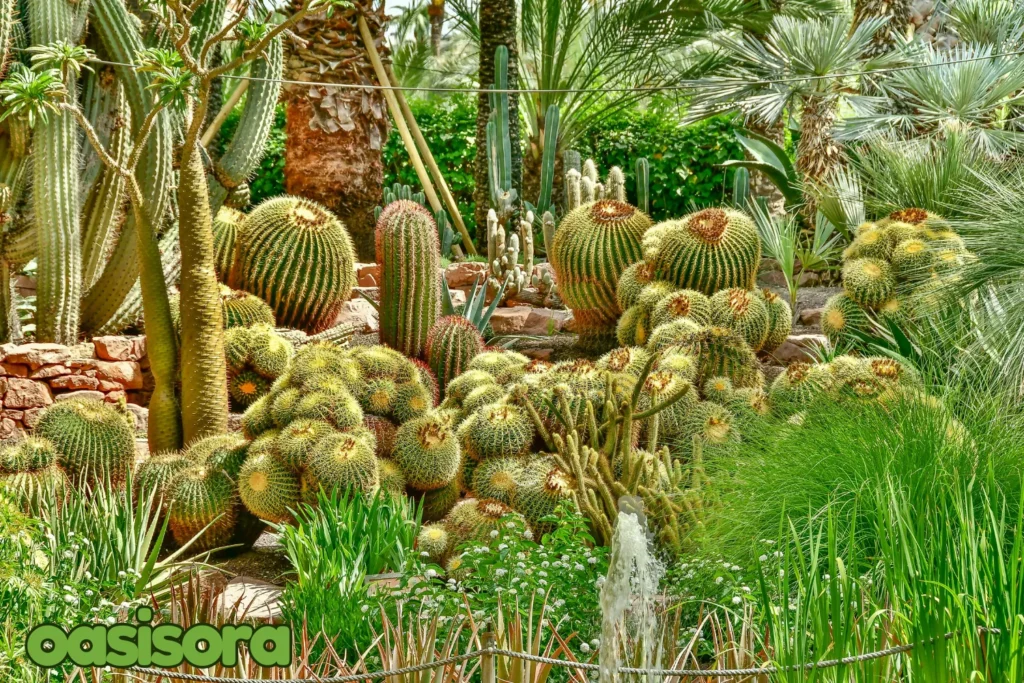
Desert trees are a smart choice for transforming your yard into a beautiful, eco-friendly landscape. These low-water, heat-tolerant trees add shade, color, and structure to any garden. Adding desert plants and shrubs is a fantastic idea!. Succulents and cacti bring a touch of desert charm like Portland’s Northwest landscape, offering eco-friendly, water-efficient beauty with unique forms and vibrant blooms.
And also Oregon’s desert landscape inspired me to share the perks of these low-maintenance, water-saving plants. Perfect for modern desert landscape designs, these resilient trees and shrubs thrive in harsh climates, offering:
- Water conservation
- Ecological value
- Stylish and low-maintenance Design
Read about 42 stunning desert trees and shrubs that improve sustainability and water efficiency while adding shade, color, and elegance to modern spaces.
So, let’s get started!.
Tl; DR
- Because they need less water to flourish, desert trees are ideal and flawless for water-efficient gardens.
- These trees offer unique beauty, from iconic Joshua Trees to vibrant Palo Verde blooms, adding visual appeal.
- By incorporating such trees, you’ll support local wildlife and enhance biodiversity in your landscape.
- Desert trees need minimal upkeep, saving time and resources compared to non-native species.
- These trees offer versatile solutions for diverse design needs: shade, ornamentation, and privacy.
- Such trees withstand harsh conditions, ensuring robust and sustainable landscape growth.
- Selecting desert trees stabilizes soil and reduces water consumption, promoting ecological harmony.
Where Can Desert Trees Grow?
Desert trees flourish in USDA Hardiness Zones 7-11, covering regions with minimum temperatures from 0°F to above 40°F. Here’s a zone-by-zone breakdown:
Hardiness Zones
| USDA Zones 7-8: | High desert and lower desert regions of New Mexico, Arizona, and Texas are included in such zones. Desert trees in this area must endure the cooler temperatures and occasional frost. |
| USDA Zones 9-10: | in such zones, the Desert trees thrive in the southwestern US, covering Arizona, California, Texas, and New Mexico. Frost is minimal, matching the natural habitat of many desert-adapted species. |
| USDA Zone 11: | California, Arizona, Texas, and Florida share a climate perfect for desert trees that thrive in heat with minimal frost risk in these zones. |
The Sonoran, Chihuahuan, and Mojave deserts are home to resilient desert trees and shrubs, perfectly suited to each region’s unique soil and climate conditions.
What are the Top 42 Desert Trees to Plant in a Water-wise and Eco-friendly Garden?
These categories highlight desert landscape options that balance:
- Drought tolerance
- Visual appeal
- Ecological benefits
- And creating resilient, beautiful, and environmentally friendly outdoor spaces.
Flowering and Ornamental Trees
1. Paloverde (Parkinsonia aculeata)
Retama, Mexican Paloverde, Jerusalem Thorn
| Native to: | Mexico, Southwestern U.S., and Northern South America |
| USDA Zones: | 8-11 |
| Pros: | Lively yellow blossoms, green photosynthetic bark, and drought-tolerant. |
| Considerations: | it drops yellow pods and flowers; some species of this plant have thorns. |
Your desert environment will be made more elegant by the stunning Paloverde tree, which has thick green bark and beautiful yellow blooms.
This drought-tolerant, medium-water-required deciduous tree adds style without taking up much space in your yard.
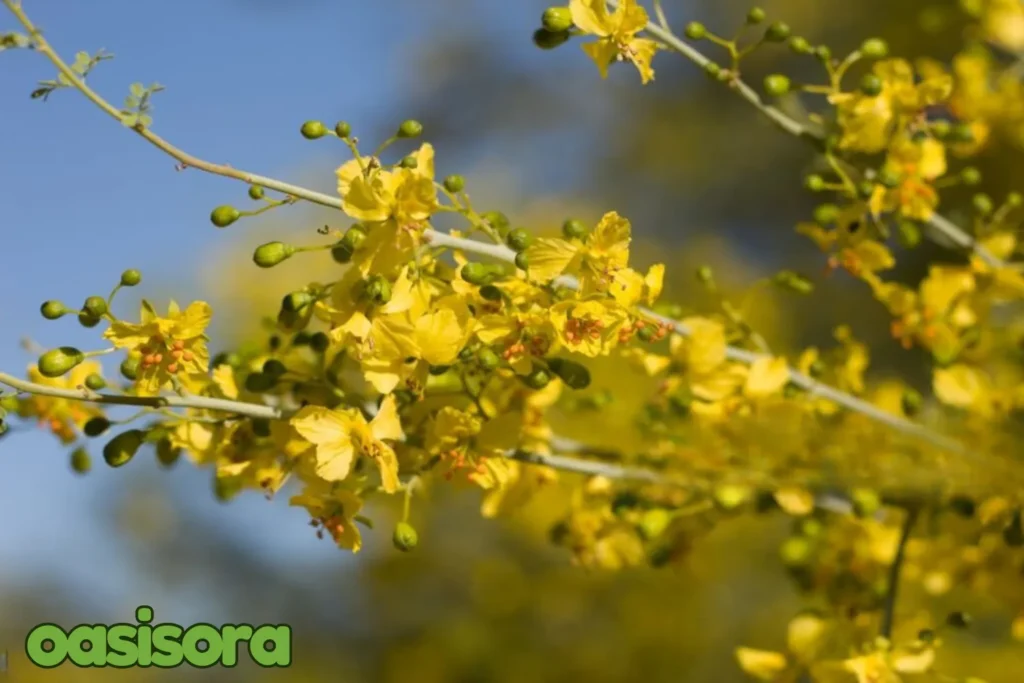
Paloverde – (Parkinsonia aculeata)
2. Ironwood Tree (Olneya tesota)
| Native to: | Sonoran Desert |
| USDA Zones: | 9-11 |
| Pros: | It has purple flowers and a thick canopy, requires less water, and provides shade to wildlife. |
| Considerations: | Slow-growing; needs soil that drains properly. |
Ironwood’s stunning purple blossoms and lush branches make a beautiful centerpiece in your yard. This deciduous tree adds structure and supports local wildlife.
Fun fact: Its edible flowers add flavor to the salads and sweets.

Ironwood Tree – (Olneya tesota)
3. Desert Willow (Chilopsis linearis)
| Native to: | Southwestern United States, Mexico |
| USDA Zones: | 7-9 |
| Pros: | Can endure dryness and Hummingbirds are attracted to their flowers. |
| Considerations: | Prefer the well-drained soils and full sunlight. |
Did you know that the Desert Willow shines as a compact ornamental gem in your yard as it grows 15-40 feet tall?
Isn’t it interesting?
This plant’s orchid-like blooms, lush green foliage, and open canopy make it a superb border for garden corners or a chic focal point in your outdoor oasis.
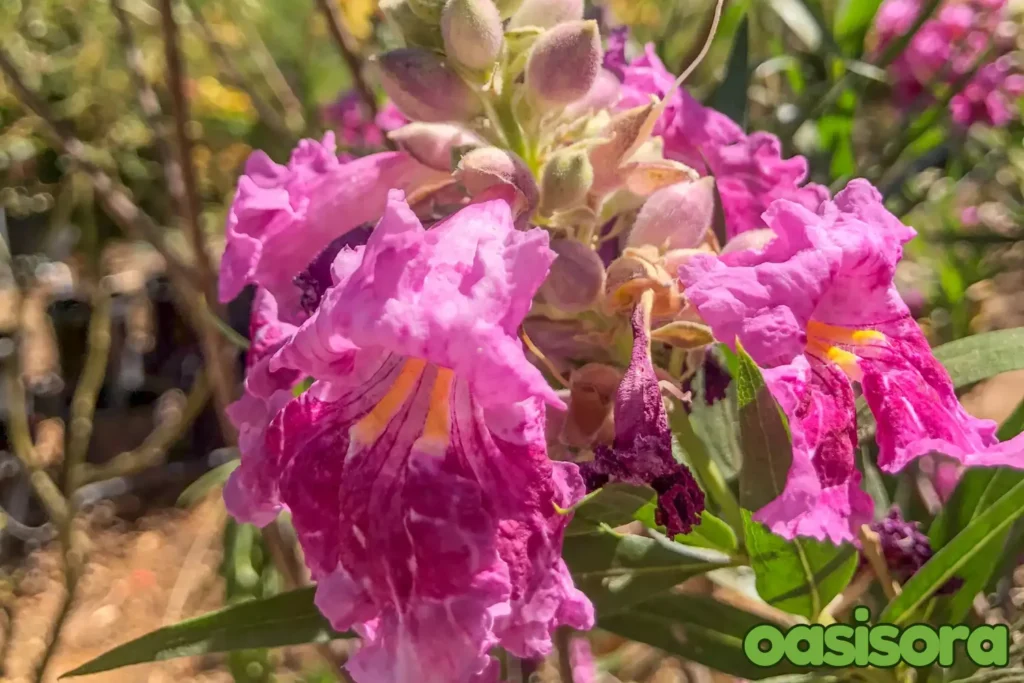
Desert Willow – (Chilopsis linearis)
4. Smoketree (Psorothamnus spinosus)
| Native to: | Southwestern U.S. |
| USDA Zones: | 8-11 |
| Pros: | Squeezed small size, resistant to drought, has complex branch structure, and matchless purple blooms. |
| Considerations: | Spiny, almost entirely leafless, prefers well-drained soils; prune trees for shape. |
Smoketree, a shrub-like plant, grows up to 25′ or more. Its deciduous foliage is mostly leafless year-round. Silvery-grey, spiny branches create an irregular shape.
You can use Smoketree for sculptural interest and texture in your garden. It can pair well with your rock gardens and cacti.
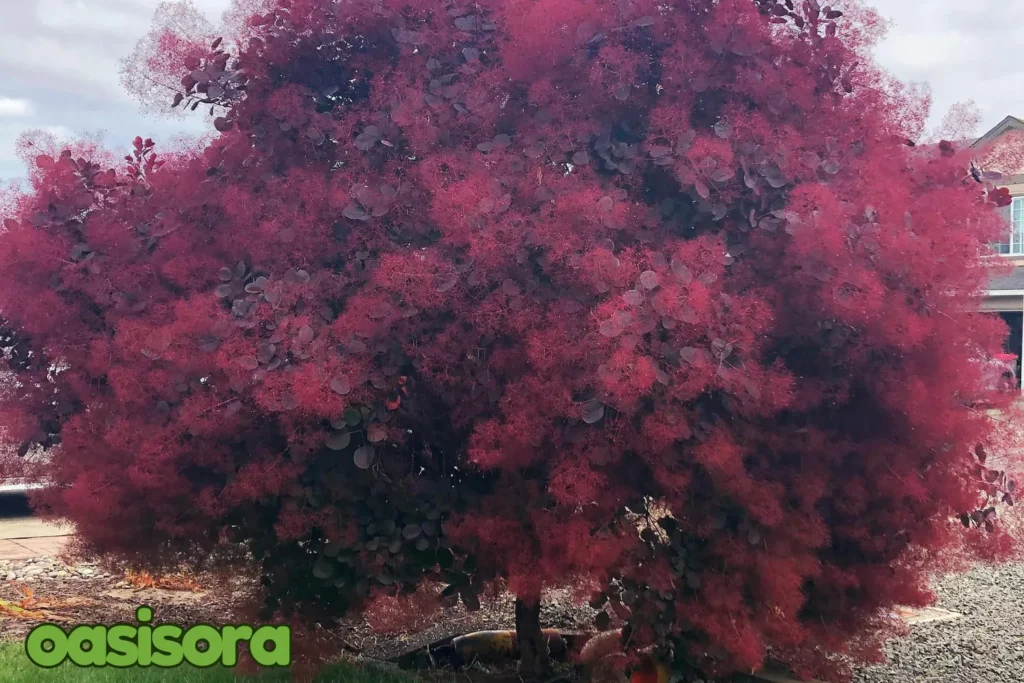
Smoketree – (Psorothamnus spinosus)
5. Texas Ebony (Ebenopsis ebano)
| Native to: | Southern Texas and Northeastern Mexico |
| USDA Zones: | 9-11 |
| Pros: | Drought-tolerant, aromatic flowers, and thick foliage. |
| Considerations: | Slow-growing, produces seed pod |
Want a stunning yard? Then, consider Texas Ebony in your yard. Native to Texas’s Chihuahuan Desert, the Texas Ebony is an exciting and exquisite evergreen tree. It boasts fragrant white flowers and makes an ideal:
- Privacy screen
- Striking shade tree
Its natural beauty adds elegance to any landscape design for desert areas.

Texas Ebony – (Ebenopsis ebano)
6. Catclaw Acacia (Senegalia greggii)
| Native to: | Southwestern United States and Northern Mexico |
| USDA Zones: | 9-11 |
| Pros: | Its energetic yellow flowers are perfect for natural fencing, are drought tolerant, and attract bees and butterflies. |
| Considerations: | Thorns are present in it, potential invasiveness in some areas, and toxic leaves or twigs are hazardous to animal health. |
Catclaw Acacia can add a dash of wilderness allure to your landscape.
It is wonderful for naturalistic arrangements because of its bright yellow blooms and rustic appearance.
Can fit perfectly in your yard with hardy native plants.
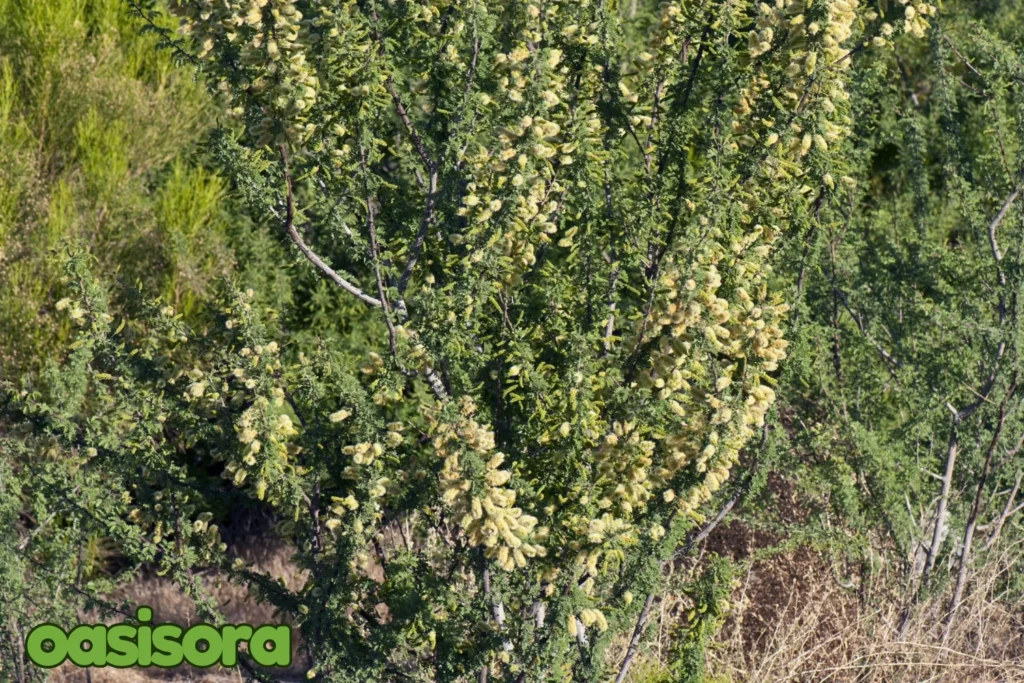
Catclaw Acacia – (Senegalia greggi)
7. Desert Museum Palo Verde (Parkinsonia ‘Desert Museum’)
| Native to: | Hybrid, developed in Arizona |
| USDA Zones: | 8-9 |
| Pros: | Thorn is less vibrant, this tree bursts with yellow blooms and grows rapidly. |
| Considerations: | For optimal growth, provide regular watering during establishment, ensure well-drained soil, and trim occasionally. |
Meet the Arizona’s spectacular state tree, the Palo Verde! This thornless hybrid boasts:
- Prolific blooms
- Longer flowering season
- Low-maintenance requirements
Ideal for colorful, carefree landscape focal points.

Desert Museum Palo Verde – (Parkinsonia ‘Desert Museum)
8. Blue Palo Verde (Parkinsonia florida)
| Native to: | Southwestern United States. |
| USDA Zones: | 8-11 |
| Pros: | It grows quickly and has lovely blue-green bark and golden blooms. |
| Considerations: | Drops pods and flowers can be messy. |
Elevate your landscape with the Blue Palo Verde tree! It is decorated with blue-green bark and bright yellow flowers. With its striking blue-green trunk and vibrant yellow blooms, the Blue Palo Verde tree offers:
- Shade and shelter
- Pollinator attraction
- Visual appeal as a focal point
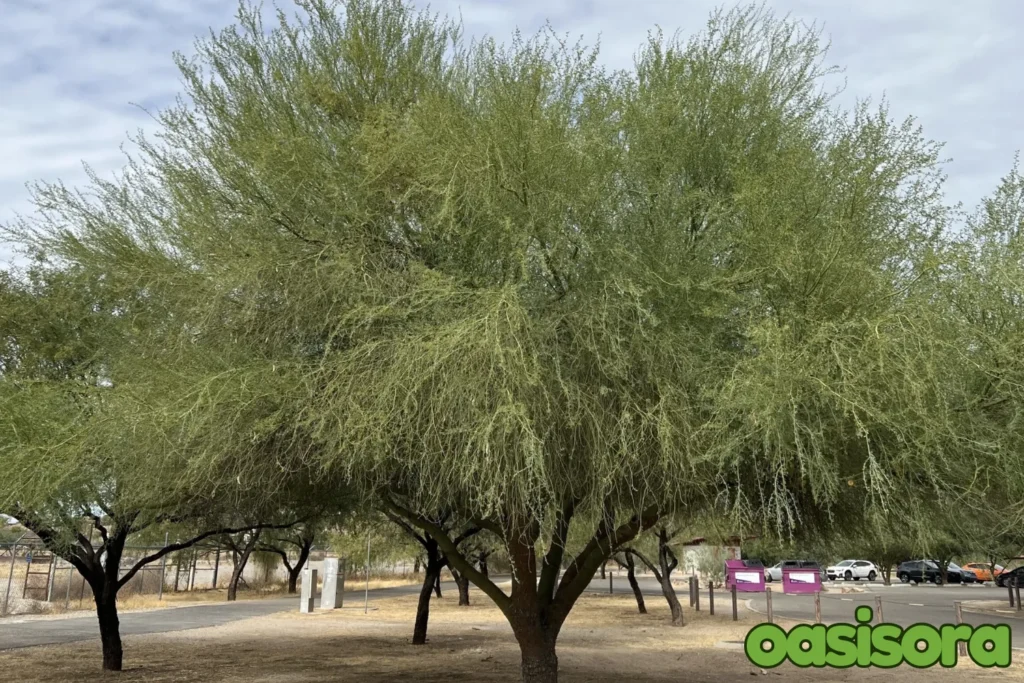
Blue Palo Verde – (Parkinsonia florida)
9. Ocotillo (Fouquieria splendens)
| Native to: | Southwestern U.S and North Mexico |
| USDA Zones: | 8-11 |
| Pros: | Attracts hummingbirds, and has vibrant bright red flowers for stunning visual impact, Drought-tolerant for low-maintenance upkeep |
| Considerations: | Their Spiky stems lose leaves and go dormant during dry seasons. |
Elevate your landscape with Ocotillo’s unique charm! Its slender, spiky branches and vibrant flowers add soaring height and a dynamic texture to your yard.
Perfect for borders or backdrops, these desert trees add a pop of color and visual lure to your yard.
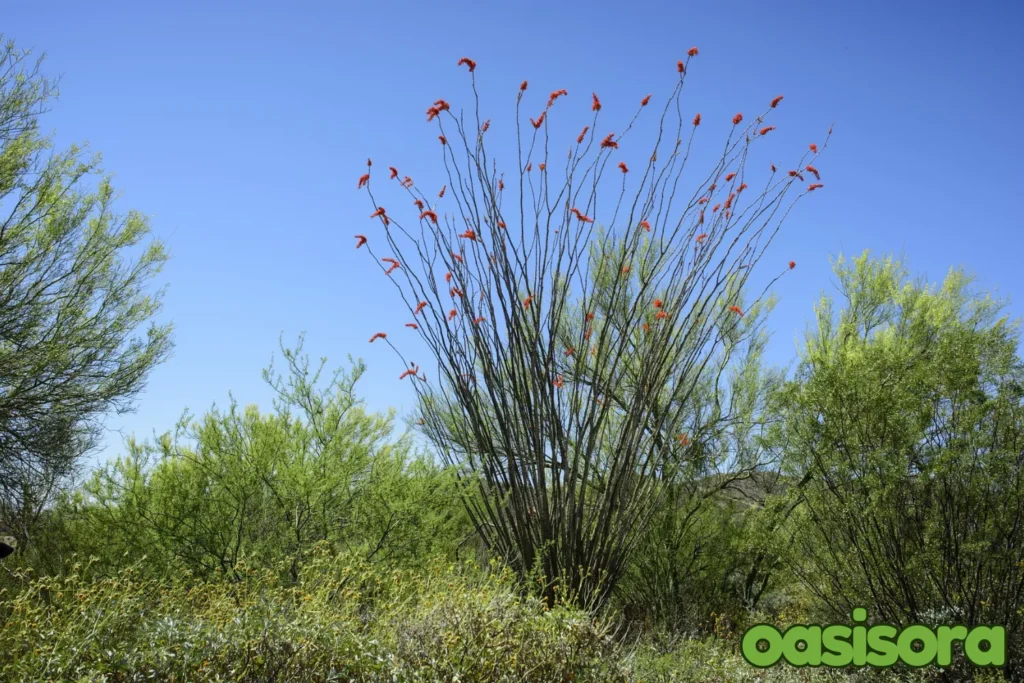
Ocotillo – (Fouquieria splendens)
10. Desert Hackberry (Celtis pallida) – Thorny shrub with bright orange berries, great for wildlife.
| Native to: | South America |
| USDA Zones: | 9-11 |
| Pros: | Resilient in dry conditions, safe and thorn-free, and offers dense shade provision |
| Considerations: | Needs space to grow; can lift pavements with roots, non-native of the mesquite trees in North America |
This tree’s thornless branches and ample shade make it ideal for family-friendly gardens, perfect near walkways or patio areas for a safe and inviting outdoor space.

Desert Hackberry – (Celtis pallida)
11. Palo Brea Tree (Parkinsonia praecox)
| Native to: | Southwestern US and Northern Mexico |
| USDA Zones: | 9-11 |
| Pros: | This amazing desert tree can survive in dry conditions, is very pretty, grows very quickly, and gives desert animals shade and protection. |
| Considerations: | Pruning Requirements: Regular pruning is needed to maintain shape and remove dead limbs Messy Seed Pods: Can litter yards and pools Thorns: Branches have sharp thorns that can cause injury |

Palo Brea Tree (Parkinsonia praecox)
The Palo Brea tree is really excellent for warmer climates to add a touch of sparky elegance to your yard. Its exciting yellow flowers bloom in the spring and create a gorgeous spectacle.
Plus, it’s awesome choice for garden lovers looking for a low-maintenance tree with plenty of appeal.
12. Cascalote Tree (Caesalpinia cacalaco)
| Native to: | Mexico and Central America |
| USDA Zones: | 9-11 |
| Pros: | It’s excellent for low-maintenance landscapes boasting vibrant yellow flowers to brighten up any yard. Plus, it has a fast growth rate and usually reaches up to 20 feet tall. |
| Considerations: | Messy Leaves: Can create litter Sensitivity to Frost: May need protection in colder climates Potential for Invasive Growth: Can spread quickly in some areas |

Cascalote Tree (Caesalpinia cacalaco)
These considerations may vary depending on your location and specific growing conditions. So keep in mind!
You will absolutely fall in love with the Cascalote Tree. Its sunny yellow flowers and weirdly wonderful seed pods make it a standout in any yard.
My neighbor has one, and it’s become a conversation starter at our block parties. The finest aspect of this desert tree? For busy households like mine, its extremely minimal maintenance requirements are ideal.
It can withstand some neglect, grows quickly, and gives the outside area a refined touch. The Cascalote Tree may be the ideal choice if you’re searching for a tree that is both lovely and a little strange.
13. Mexican Bird of Paradise (Erythrostemon mexicanus)
| Native to: | Mexico and Southwestern United States |
| USDA Zones: | 8-11 |
| Pros: | Its brilliant yellow, orange, or reddish blooms, which appear in vivid clusters, are a sight to behold and give any yard a splash of color. In addition to being reasonably low-maintenance and drought-tolerant, this tree grows rapidly to a height of around 10 feet. |
| Considerations: | Thorns: Branches can injure your hands due to their sharp thorns. Messy Seed Pods: Can litter yards and pools Sensitivity to Frost: May need protection in colder climates |

Mexican Bird of Paradise
These considerations may vary subject to your location and exact growing conditions. So, keep that in mind!
The Mexican Bird of Paradise is a real showstopper. Its bipinnate dark green foliage and beautiful yellow-reddish flowers brighten the yard and make everyone smile.
It is a good option for busy homes because of its low maintenance requirements. It grows really fast and can handle some of your neglect…ha-ha….But don’t neglect this desert tree!.
Also, it gives the outdoor area a hint of delicacy. Consider the Mexican Bird of Paradise if you’re searching for a distinctive and lovely tree.
14. Arizona Ash Tree
| Native to: | Southwestern United States and Mexico |
| USDA Zones: | 7-11 |
| Pros: | Stunning addition to any yard, vibrant green leaves, robust growth, low maintenance, drought tolerant, fast growth rate, 30-45 feet tall, broad canopy provides excellent shade. |
| Considerations: | Messy Leaves: Can create litter and require regular cleanup Susceptible to Diseases: May be vulnerable to diseases like anthracnose and Texas root rot Potential for Invasive Growth: Can spread quickly in some areas |

Arizona Ash Tree
For warm, arid areas, the Arizona Ash desert Tree, also called the Velvet Ash or Fraxinus velutina, is an excellent option. For busy households searching for a low-maintenance, attractive tree, its rapid growth rate and drought tolerance make it fantastic.
Its vivid green leaves give your outside area a sense of elegance, and it offers great shade. Further, it can flourish and grow into a lovely addition to your yard with your care.
Shade Providers
15. Chilean Mesquite (Prosopis chilensis)
| Native to: | Argentina, Chile, Bolivia, and Peru |
| USDA Zones: | 8–12 |
| Pros: | Fast-growing, drought-tolerant, beautiful flowers/pods |
| Considerations: | Drop pods/leaves, potential invasiveness |
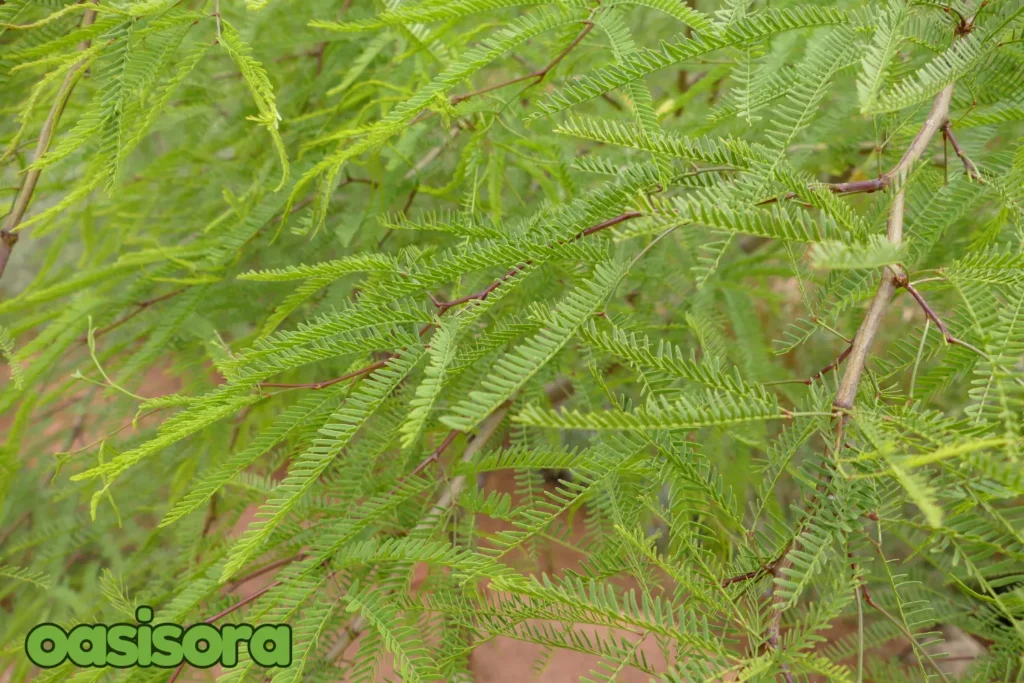
Chilean Mesquite – (Prosopis chilensis)
The Chilean Mesquite is a breathtaking desert shade tree, featuring:
- Brilliant Yellow-White Blossoms
- Elegant Seed Pods
- Dramatic Brown Bark
- And Lush Green Foliage
Majestic Growth up to 30 feet tall and 40 feet wide. For your outdoor space, it’s a wonderful shelter from nature!
16. Velvet Mesquite (Prosopis velutina)
| Native to: | Southwestern U.S. and Mexico |
| USDA Zones: | 8-11 |
| Pros: | With its thick shade and drought resistance, this plant is ideal for arid regions, ensuring sustainability and aesthetic appeal. |
| Considerations: | Drop pods may require cleanup. |
Velvet Mesquite’s thick plush foliage creates lush, shaded areas in your desert surroundings or landscape.
They are flawless for escaping the heat and offering peaceful oasis settings.

Velvet Mesquite – (Prosopis velutina)
17. Screwbean Mesquite (Prosopis pubescens)
| Native to: | Southwestern U.S. and Mexico |
| USDA Zones: | 7-11 |
| Pros: | Specially twisted seed pods, nitrogen-fixing, and shade-giving roofs. |
| Considerations: | It spreads quickly, can be invasive, and produces thorns. |
Bring personality to your outdoor space with Velvet Mesquite’s Quirky seed pods and sculptural branches. They are ideal for:
- Nature-inspired gardens
- Wildlife habitats
- Unique landscape designs.
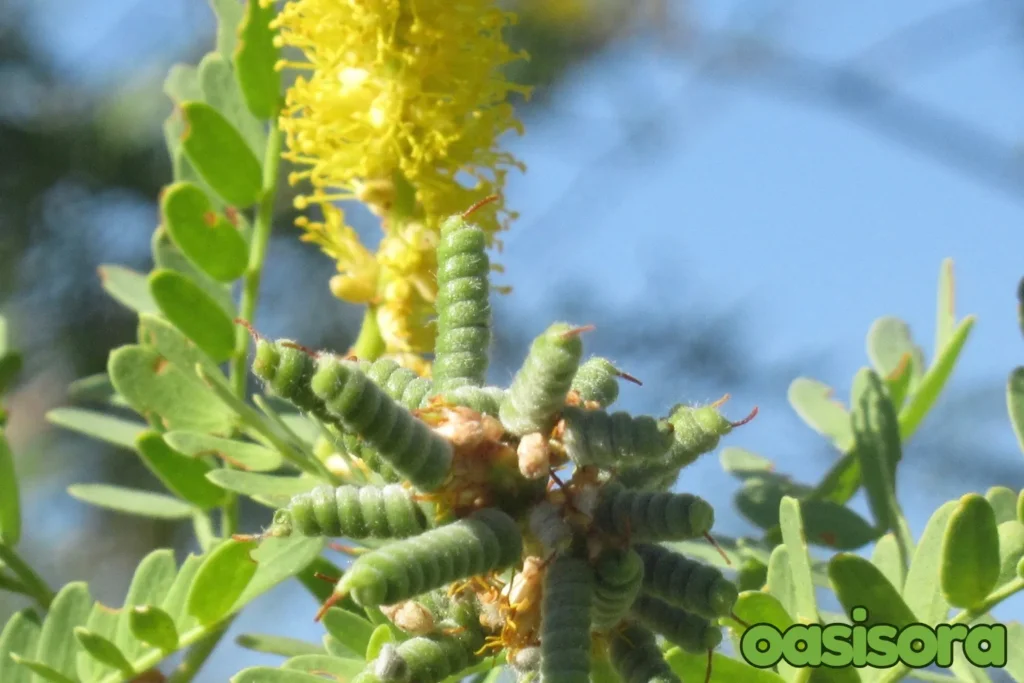
Screwbean Mesquite – (Prosopis pubescens)
18. Honey Mesquite (Prosopis glandulosa)
| Native to: | Southwestern U.S. and Mexico |
| USDA Zones: | 7-11 |
| Pros: | Fragrant flowers, are shady and are drought-tolerant. |
| Considerations: | Invasive roots; produce thorns and pods. |
Honey mesquite’s beautiful twisty branches, vivid green foliage, and fragrant blossoms make it a wonderful addition to any yard.
These desert trees can also provide your garden personality, shade, and charm.
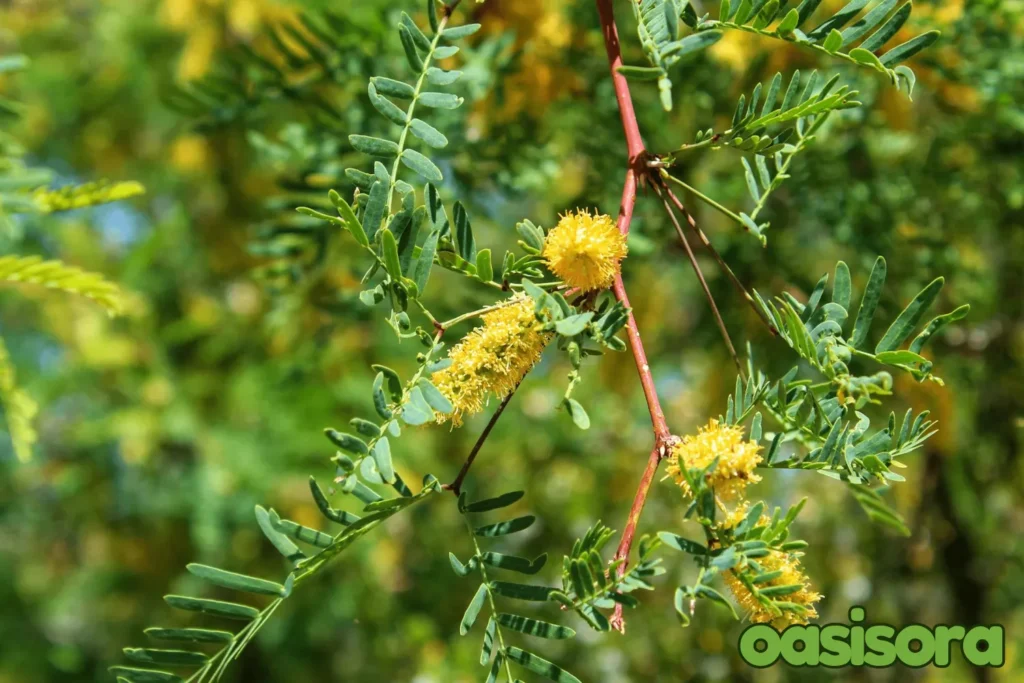
Honey Mesquite – (Prosopis glandulosa)
19. Desert Fern (Lysiloma thornberi) – A dense, shade-providing tree with fern-like leaves.
| Native to: | Mexico’s northern Sonora and southern Arizona. |
| USDA Zones: | 9 |
| Pros: | This plant is easy to care for and is considered low-allergenic and habitat to wildlife. |
| Considerations: | Requires occasional watering during extreme drought, drops leaves in cold winters, grows large (up to 20×15 ft), needs occasional pruning, and has thorns. |
If you need a low-maintenance desert plant. Then add Desert Fern to your yard for its lush shade, unique foliage, and creating wildlife-friendly spaces. It’s perfect for a minimal oasis.
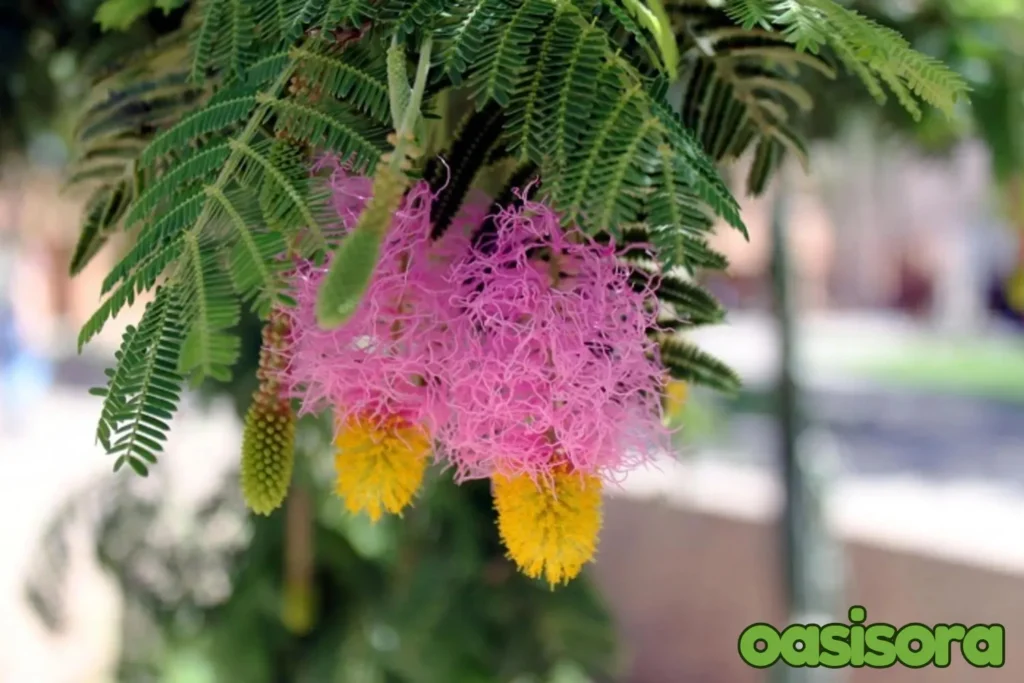
Desert Fern – (Lysiloma thornberi)
20. Texas Mountain Laurel (Sophora secundiflora) – Evergreen shrub or small tree with fragrant purple flowers.
| Native to: | West and Central Texas, Mexico. |
| USDA Zones: | 7-10 |
| Pros: | It has purple blooms, a pleasant scent, can withstand drought, and needs minimal care. |
| Considerations: | Deadly seeds or pods that grow slowly and might need to be pruned. |
The Texas Mountain Laurel can bring luxurious purple beauty and sweet fragrance to your landscape, flourishing with minimal care and drought tolerance, but beware of toxic seeds/pods.

Texas Mountain Laurel – (Sophora secundiflora)
21. Sweet Acacia (Acacia farnesiana)
| Native to: | Tropical and subtropical regions |
| Pros: | Depending on the area, it might be either deciduous or evergreen desert trees. It can grow to be 15-30 feet tall, with many trunks. Also features whitish-gray bark, prickly branches, and dark brown seed pods. |
| Considerations: | Thorns: Can cause injury if not handled carefully Potential for Invasive Growth: Can spread quickly and take over other plants Sensitive to Frost: May need extra defense in cold weather |

Sweet Acacia (Acacia farnesiana)
Vachellia farnesiana, aka Sweet Acacia, is a type of tree that usually grows in warmer places. It possesses good, smelly yellow flowers and pretty leaves. The tree can offer these remarkable perks, too:
- Perfume
Flowers are distilled to make cassie perfume.
- Gum
The tree produces a collectible gum.
- Tanning Leather
Bark and seed pods contain tannin for leather tanning.
- Food
Young leaves, flowers, and seed pods are edible.
- Fodder and Forage
Foliage is high in protein, good for livestock and bees.
- Ornamental
Used in xeriscaping for its drought tolerance.
- Dyes and Inks
Bark and fruit make a black pigment.
- Traditional Medicine
Used to treat various ailments, including malaria and skin diseases.
22. Southern Live Oak (Quercus virginiana)
| Native to: | Southeastern United States |
| USDA Zones: | 7-11 |
| Pros: | Majestic evergreen desert tree, stunning sprawling branches, broad canopy provides excellent shade, long-lived, low maintenance, supports local wildlife, 40-60 feet tall. |
| Considerations: | Large Size: Can require significant space and pruning Leaf Litter: Can create litter and require regular cleanup Susceptible to Diseases: May be vulnerable to diseases like oak wilt and root ro |
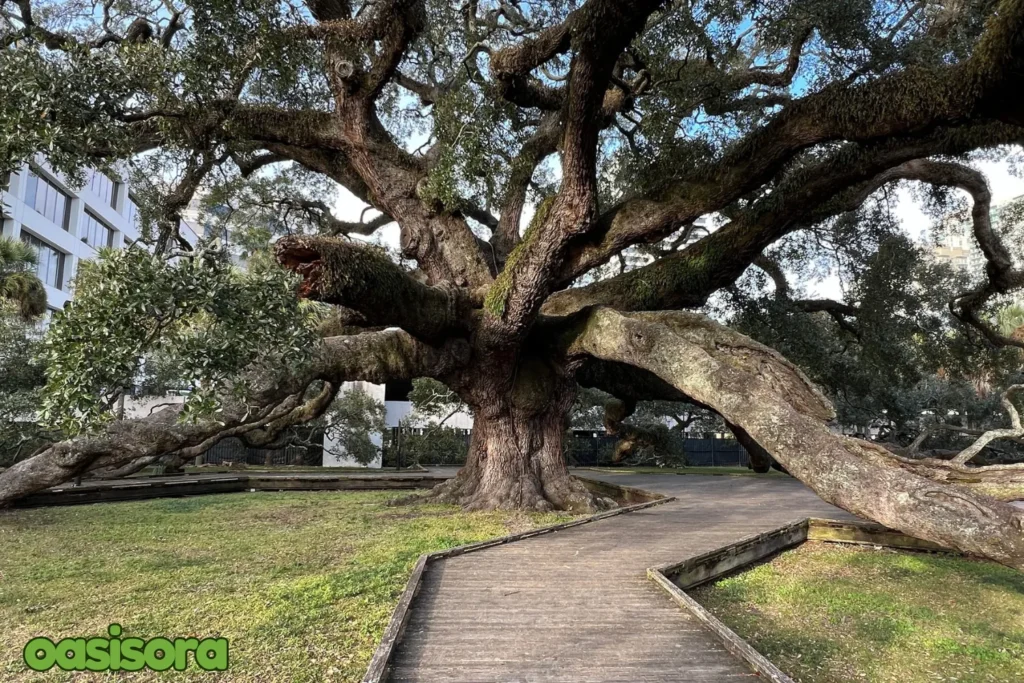
Southern Live Oak
For warm, humid areas, the Southern Live Oak is an excellent option. For households searching for a low-maintenance, attractive tree, its long lifespan and broad canopy make it fantastic.
Its sprawling branches give your outside area a sense of elegance, and it offers great shade. Further, it can flourish and grow into a lovely addition to your yard with your care.
Evergreen and Pine Trees
23. Aleppo Pine (Pinus halepensis)
| Native to: | Mediterranean region |
| USDA Zones: | 9-11 |
| Pros: | Drought-tolerant, soil-versatile plant, flawless for minimal landscaping. |
| Considerations: | Cones and needle drops, which are not native to North America, can cause a problem when you establish a native garden. |
The rough appearance and evergreen leaves of Aleppo Pine can add a Mediterranean touch and grace to your yard. Add enduring charm to your landscape with these trees, suitable as windbreaks or solo statement pieces.

Aleppo Pine – (Pinus halepensis)
24. Bristlecone Pine (Pinus longaeva)
| Native to: | Southwestern United States. |
| USDA Zones: | 4-8 |
| Pros: | Highly resistant to damage, durable, and unique-looking. |
| Considerations: | Slow-growing; favors particular high-altitude circumstances. |
Use this ancient desert tree in your area to add a timeless and rugged look to your landscape, ideal as a sample tree. If you live in a harsh atmosphere it is perfect for your yard.
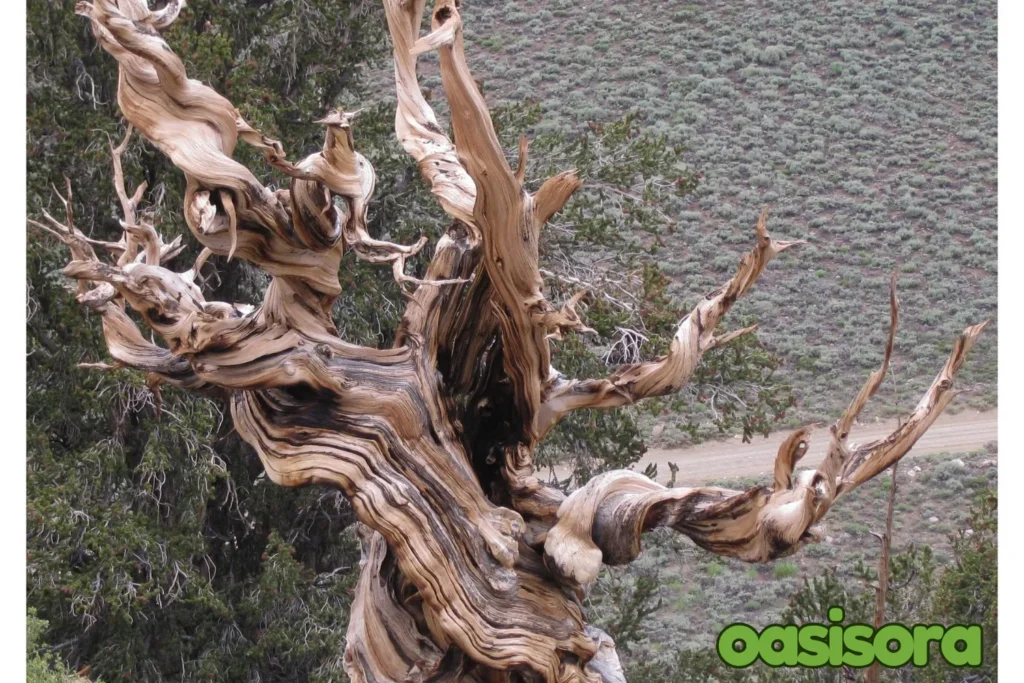
Bristlecone Pine – (Pinus longaeva)
25. Pinyon Pine (Pinus edulis)
| Native to: | Southwestern United States. |
| USDA Zones: | 5-9 |
| Pros: | Evergreen, drought-tolerant, and edible nuts. |
| Considerations: | Slow-growing and vulnerable to pests under stress. |
Maximize the potential of your small space garden with the beautiful Pinyon Pine! Its tiny size and delicious edible nuts serve two functions, and its unusual sculptured form creates a lovely focal point for your serene Zen garden in the desert.
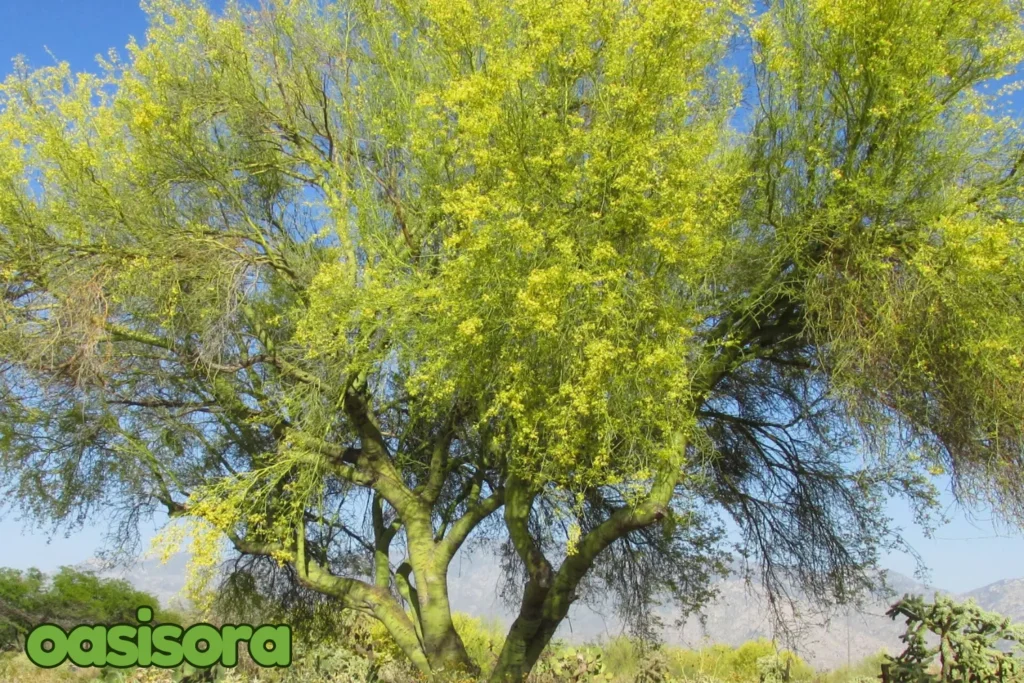
Pinyon Pine – (Pinus edulis)
26. California Fan Palm (Washingtonia filifera)
| Native to: | California and Arizona |
| USDA Zones: | 8b-11 |
| Pros: | Once established, the classic palm shape provides habitat and can endure drought. |
| Considerations: | It can get rather big, needs room, and leaves a lot of leaf litter. |
Imagine having a backyard shelter surrounded by palm trees! It is made possible by the California Fan Palm, whose magnificent presence takes you away to a world of peace and beauty.
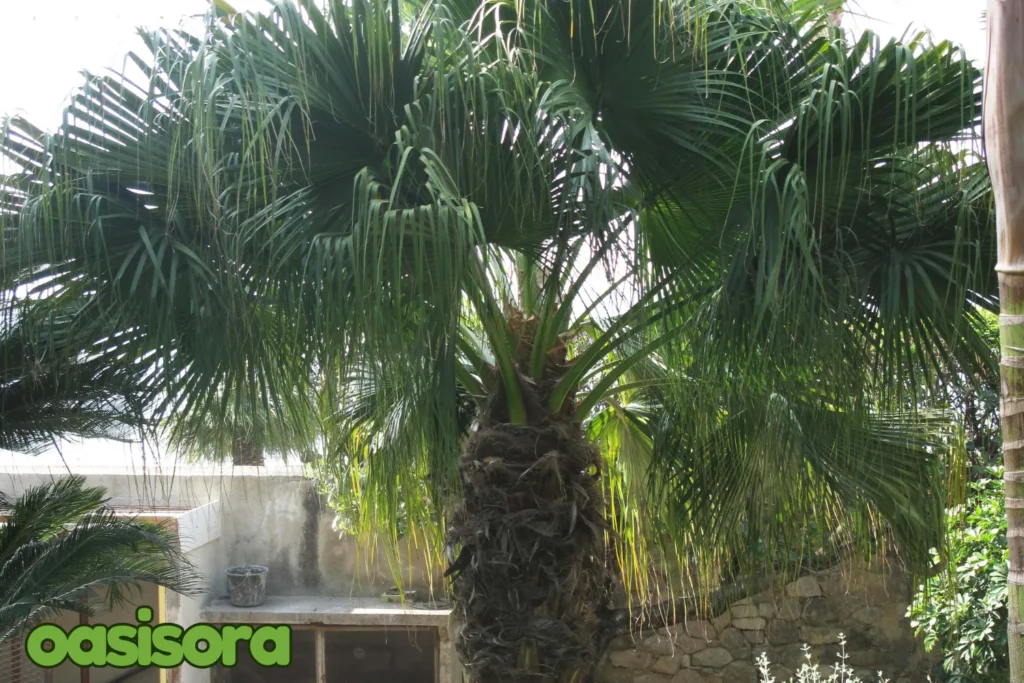
California Fan Palm – (Washingtonia filifera)
27. Eldarica Pine (Pinus eldarica) – Known for its dense canopy, suitable for desert landscaping.
| Native to: | Georgian and Azerbaijani arid mountain regions |
| USDA Zones: | 6–11 |
| Pros: | Fast growth, drought tolerant, evergreen, fragrant. |
| Considerations: | Large size, drops needles, requires pruning. |
The Eldarica Pine is a lovely, low-maintenance desert tree that grows rapidly, thrives in drought conditions, and is ideal for adding natural serenity to the space.
Thus, the Eldarica Pine is a great choice if you want to create a calm haven or add some greenery to your yard.

Eldarica Pine – (Pinus eldarica)
28. Palo Blanco (Acacia willardiana)
| Native to: | Southwestern United States and Mexico |
| USDA Zones: | 9-11 |
| Pros: | Striking white exfoliating bark and slender, weeping branches, it is drought tolerant and can thrive in low-water conditions. Plus, it is perfect for water-conscious landscapes and requires minimal care. Adds elegance to small gardens, courtyards, and entryways and is a great wildlife supporter. |
| Considerations: | Frost Sensitivity: May require protection in areas with frequent frosts Limited Space: Grows relatively small, 15-25 feet tall, but still needs careful placement Leaf Litter: Sheds leaves seasonally, requiring occasional cleanup |
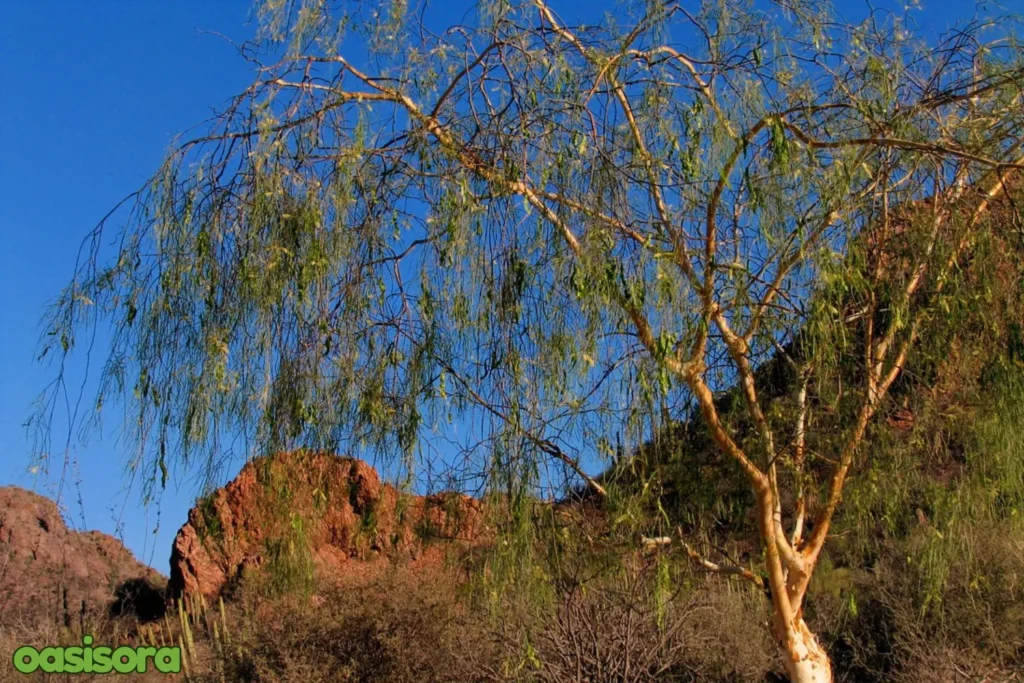
Palo Blanco
Are you looking for a tree that’s as spectacular as well as low-maintenance? Then, the Palo Blanco (Acacia willardiana) is a desert tree for you. With white exfoliating bark and weeping branches, it’s really super for small gardens and drought-tolerant landscapes.
Iconic Desert Trees
29. Joshua Tree (Yucca brevifolia)
| Native to: | Mojave Desert |
| USDA Zones: | 8-10 |
| Pros: | Iconic appearance, low water needs, evergreen. |
| Considerations: | Slow-growing; limited to specific desert environments. |
Design a breathtaking desert landscape with the Joshua Tree’s architectural beauty! It’s:
- Sculptural branches
- Unique, tree-like shape
- Gorgeous sunset silhouettes are ideal for crafting a unique and dramatic outdoor setting.
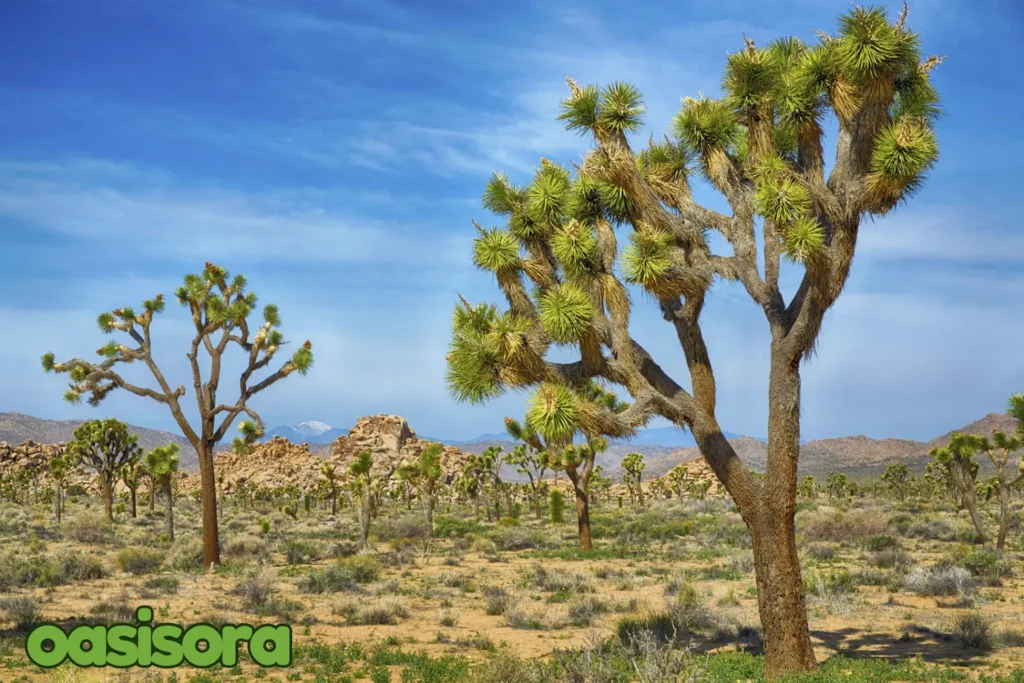
Joshua Tree – (Yucca brevifolia)
Hey, wait! There’s a lot more to discuss with you. So, stay tuned till the end.
30. Saguaro Cactus (Carnegiea gigantea)
| Native to: | Mexico, Sonoran Desert United States |
| USDA Zones: | 9-11 |
| Pros: | Long lifespan, iconic desert design, and habitat for wildlife. |
| Considerations: | Slow growth, needs clear and open space to grow. |
The renowned Saguaro Cactus will let you experience the wonderful spirit of the Sonoran Desert! Its powerful shape and classic appeal take you to an era of tough elegance.

Saguaro Cactus – (Carnegiea gigantea)
31. Creosote Bush (Larrea tridentata)
| Native to: | Mexico and Southwest United States’ deserts |
| USDA Zones: | 8-11 |
| Pros: | Evergreen, very drought-tolerant, and has a matchless rain aroma. |
| Considerations: | Can dominate the landscape, and inhibit the growth of nearby plants. |
Increase the diversity of your plants and add color and soft scent to your yard by adding a creosote bush!.
The low density of this bush allows it to grow without affecting walkways or other structures in your yard. This makes this bush the best choice for locations requiring low caretaking.

Creosote Bush – (Larrea tridentata)
32. Soaptree Yucca (Yucca elata)
| Native to: | Northern Mexico and the Southwestern United States |
| USDA Zones: | 7-11 |
| Pros: | drought-tolerant, pollinator-friendly, and needs little more irrigation. |
| Considerations: | Slow-growing, pointy leaves might be dangerous. |
Use soaptree yucca in your desert tree garden as a great accent plant.
It works as a natural barrier when combined with rock garden plants and the rest of the desert garden which allows for a beautiful, low-water usage design overall.
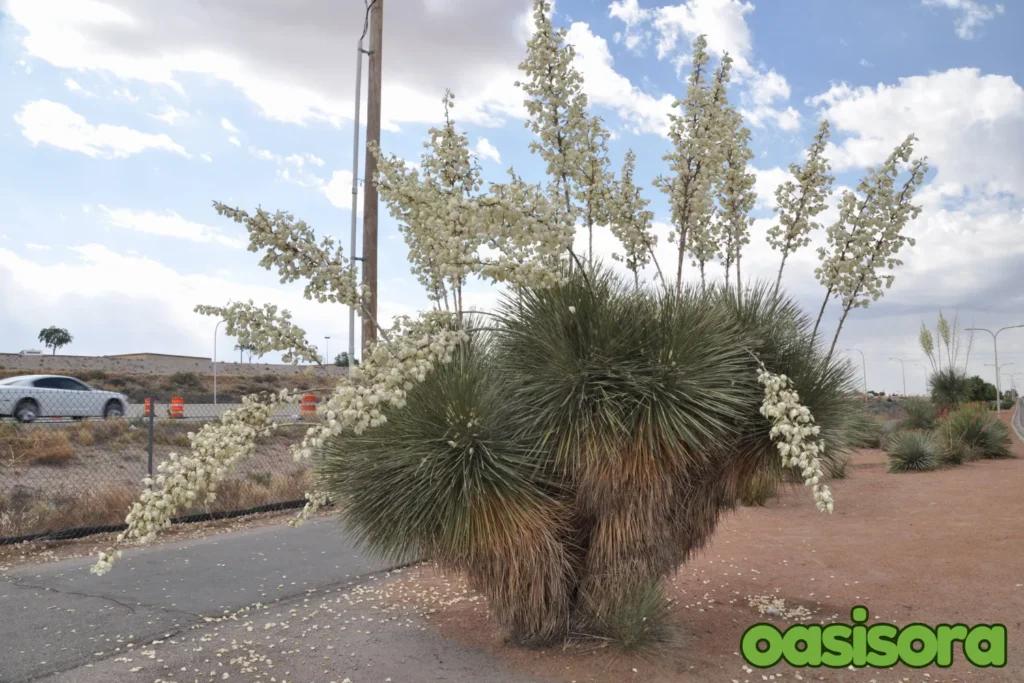
Soaptree Yucca – (Yucca elata)
33. Desert Fan Palm (Washingtonia filifera) – Iconic palm that provides visual interest and shade.
| Native to: | Southwestern United States, Baja California, Mexico |
| USDA Zones: | 9A – 11 |
| Pros: | Drought tolerant, faster growth, fabulous style. |
| Considerations: | Drops fruit/leaves, requires pruning, and may grow too large. |
Desert Fan Palm is a splendid drought-tolerant desert tree that flourishes in strong heat and can renovate your outside area.
This desert tree is perfect for your yard if you want elegant simplicity.

Desert Fan Palm – (Washingtonia filifera)
34. Jojoba (Simmondsia chinensis)
| Native to: | Southwestern U.S. and northwestern Mexico |
| USDA Zones: | 9-11 |
| Pros: | Drought-resistant, produces valuable oil, evergreen. |
| Considerations: | Slow-growing, needs male and female plants for seed production. |
Elevate your yard with the stunning Jojoba tree! This versatile, low-maintenance desert gem offers:
- Valuable seeds rich in oil
- Exceptional adaptability to harsh conditions
- Perfect for hedging, slope stabilization, or background planting
- Drought tolerance and minimal upkeep
Add a touch of sophistication and suppleness to your landscape with Jojoba. Its features make it a supreme choice for any desert yard!
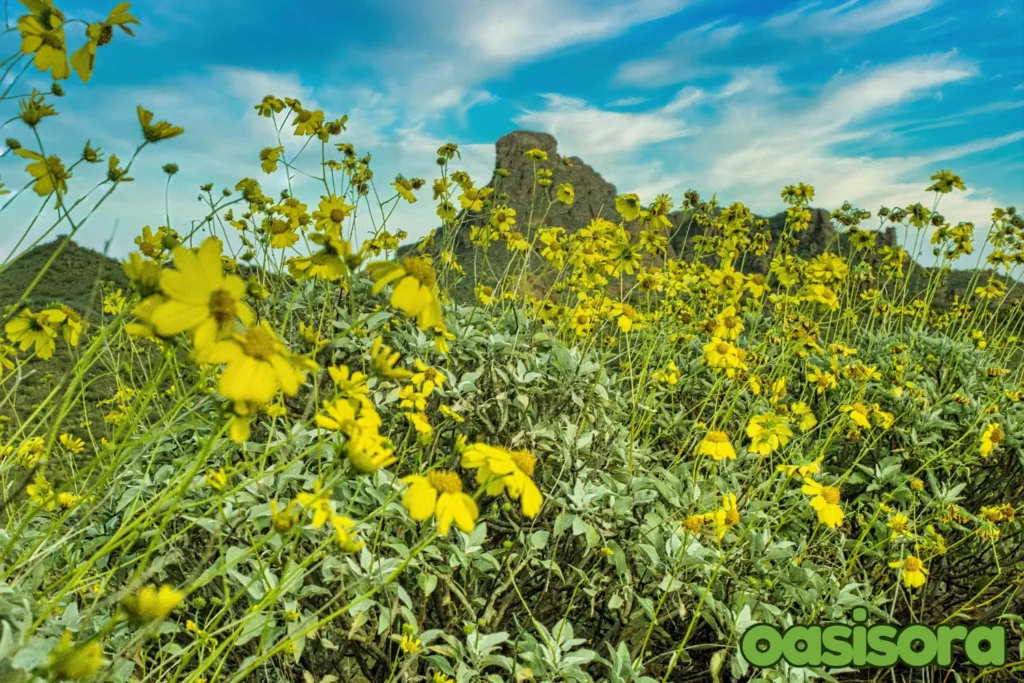
Jojoba – (Simmondsia chinensis)
35. Mormon Tea (Ephedra spp.)
| Native to: | Arid regions of the U.S. |
| USDA Zones: | 6-11 |
| Pros: | Drought-tolerant, fascinating green, segmented shoots, medicinal properties. |
| Considerations: | It lacks outdated leaves, which might charm only to some gardeners. |
Reveal the natural beauty and healing properties of Mormon Tea!.
This desert plant brings uniqueness and wellness to your landscape.
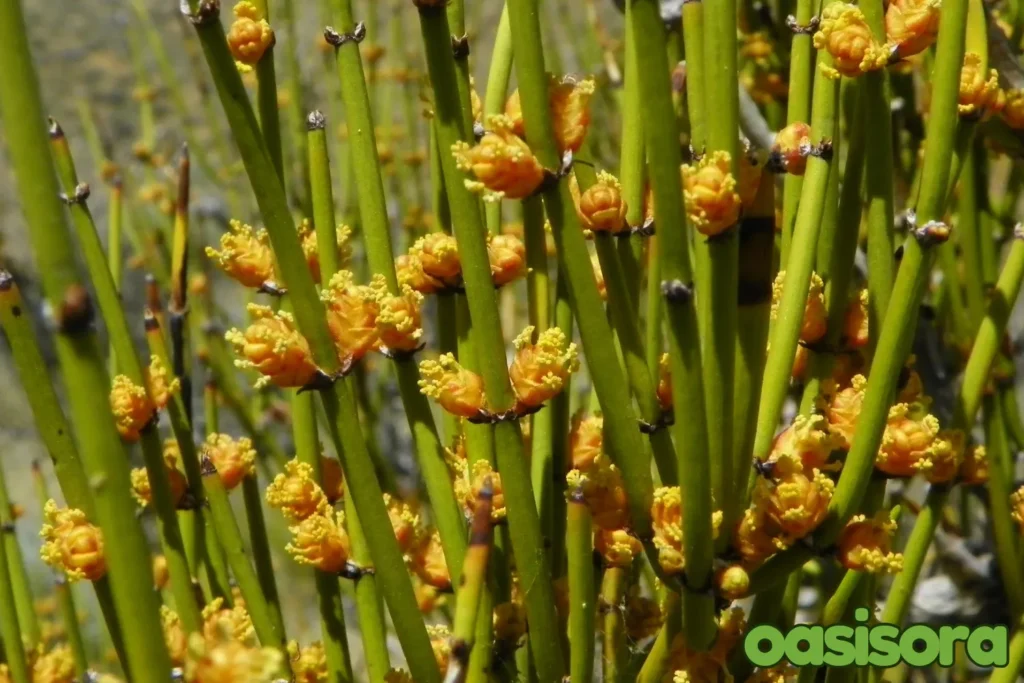
Mormon Tea – (Ephedra spp.)
36. Boojum Tree (Fouquieria columnaris)
| Native to: | Baja California, Mexico, and southern California |
| USDA Zones: | 9-11 |
| Pros: | A unique desert tree with a characteristic columnar shape, it is very drought-tolerant and low-maintenance, ideal for arid landscapes and tiring households. Plus, its flowers attract pollinators, adding to its ecological value. |
| Considerations: | Growth Rate Slow growth requires patience. Frost Sensitivity Needs protection in colder climates. Soil Needs It loves well-drained soil for optimal health. |

Boojum Tree
Folks! You have to consider these points for this plant:
The Boojum tree or Fouquieria columnaris is a strange and columnar cactus-like tree belonging to Baja California. It is recognized for its distinctive, spindly structure and capacity to grow in arid climates. The tree can grow to be 20-40 feet tall and is commonly found in desert areas…
Iconic Desert Trees
37. Red Yucca (Hesperaloe parviflora) – Striking flower spikes that attract hummingbirds.
| Native to: | Texas and Northeastern Mexico |
| USDA Zones: | 5-10 |
| Pros: | Drought tolerant, low maintenance, stunning red flowers. |
| Considerations: | Sharp leaves, slow growth, require occasional pruning. |
Want to add some Southwest charm to your garden? Look no further than Red Yucca. This low-maintenance, drought-tolerant beauty:
- Thrives in extreme temperatures
- Produces vibrant red flowers attracting hummingbirds and butterflies
- Boasts sharp, evergreen leaves
- Withstands scorching heat and freezing cold
It’s truly a perfect addition to your desert landscape!
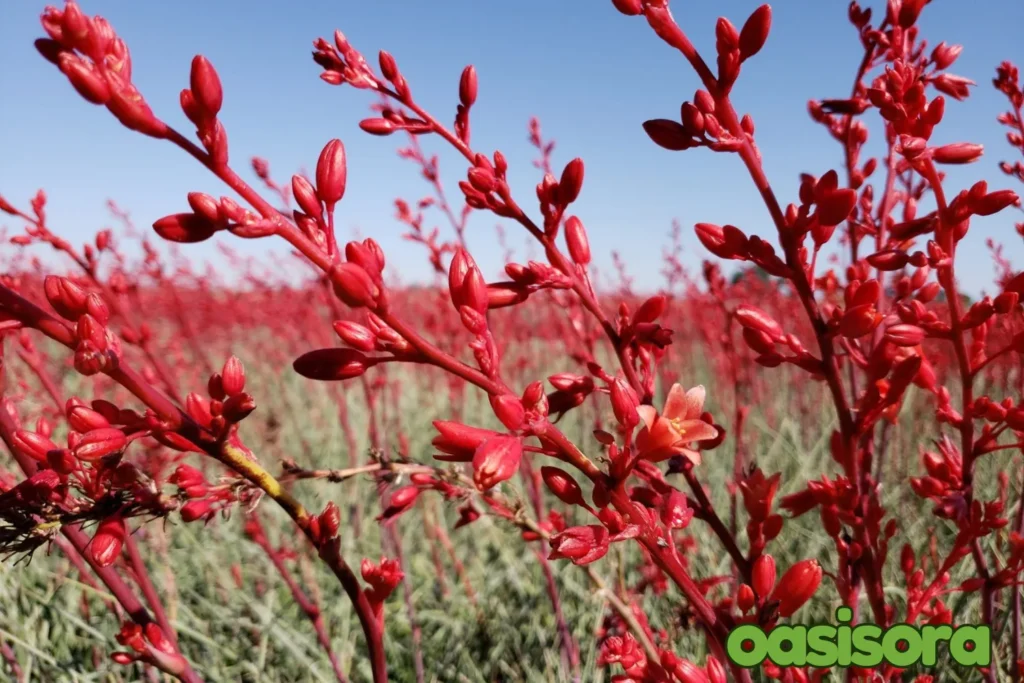
Red Yucca – (Hesperaloe parviflora)
38. Brittlebush (Encelia farinosa) – Yellow blooms and silvery foliage.
| Native to: | Southwestern United States, Mexico |
| USDA Zones: | 9-11 |
| Pros: | Yellow blooms, drought tolerant, silvery leaves. |
| Considerations: | Short lifetime and sensitive to excessive watering. |
Are you in love with the yellow color just like me? Then surely you can add a pop of yellow tint in your yard with a Brittlebush Desert tree!.
This shrub from the Southwest has rich blooms, and silvery leaves, and can withstand dryness.
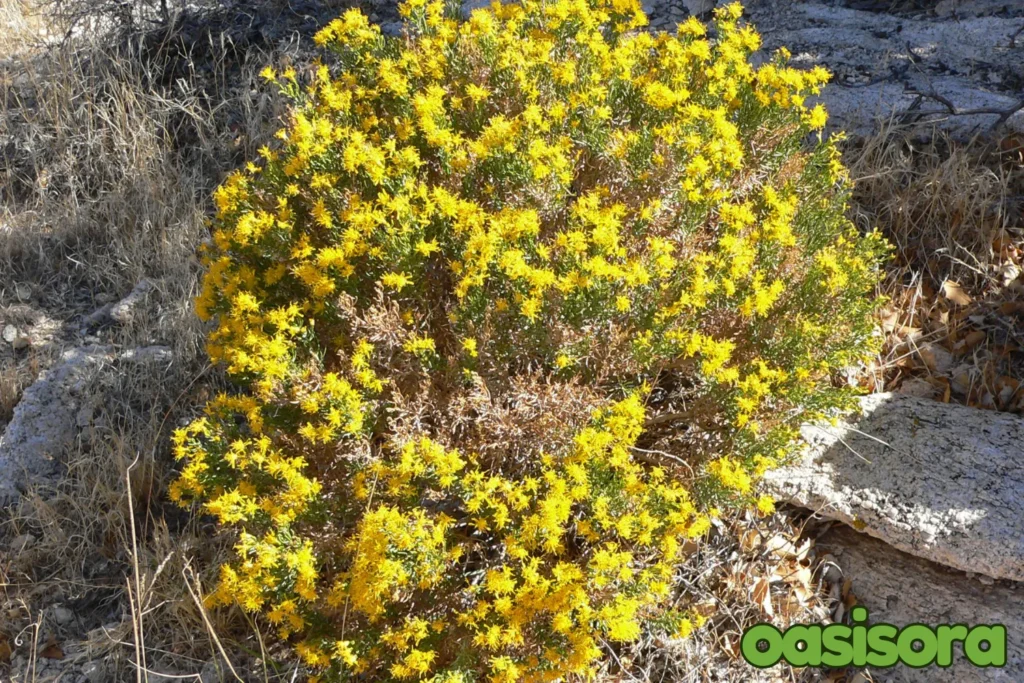
Brittlebush – (Encelia farinosa)
39. Texas Sage (Leucophyllum frutescens) – Known for its purple flowers and silvery leaves.
| Native to: | Southwestern United States, Mexico. |
| USDA Zones: | 8-10 |
| Pros: | Beautiful purple summer blooms, withstand drought, and attract hummingbirds |
| Considerations: | Slow-growing, not grow in shade, occasionally it is invasive. |
If you want to bring nature’s beauty into your yard, Texas Sage is the best choice for you.
It has incredible purple flowers with silvery leaves and is a pollinator and point of attraction for hummingbirds.
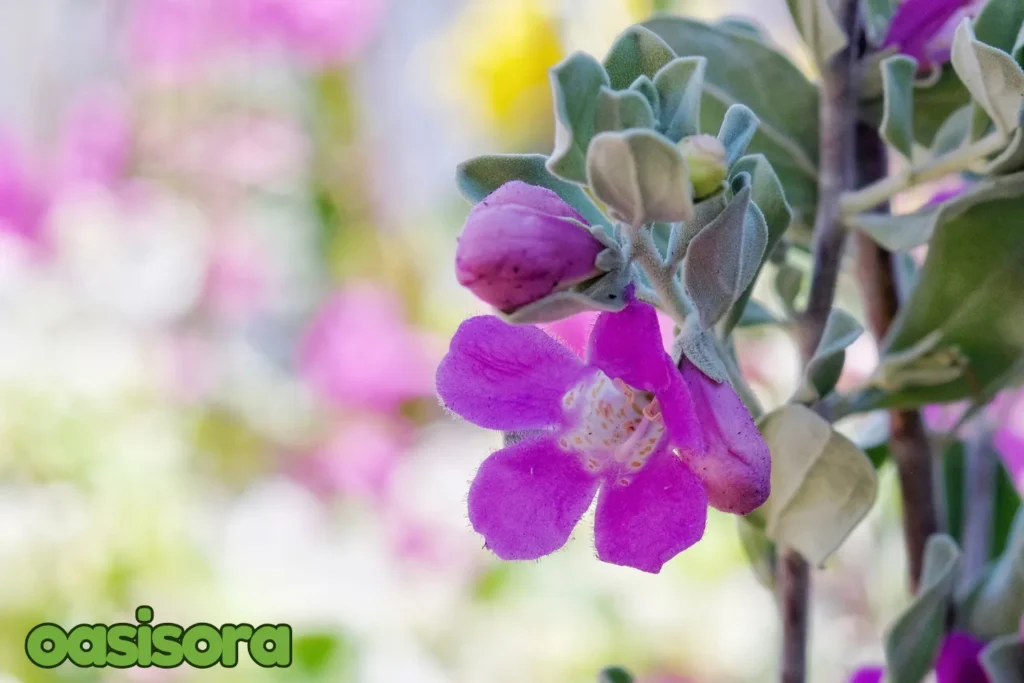
Texas Sage – (Leucophyllum frutescens)
40. Turpentine Bush (Ericameria laricifolia) – Compact shrub with dense yellow blooms.
| Native to: | Southwestern United States, Mexico. |
| USDA Zones: | 5-9 |
| Pros: | Drought tolerant, fragrant foliage, yellow-orange flowers |
| Considerations: | Slow growth, needs extra irrigation during times of extreme dryness. |
Are you looking for a hassle-free but trendy addition to your Zen garden? .
The Turpentine Bush is perfect for you then! Since it’s a low-maintenance plant and can resist drought.
This desert shrub is a good choice for you if you are a busy gardener. Also, it is ideal for creating a sustainable habitat.
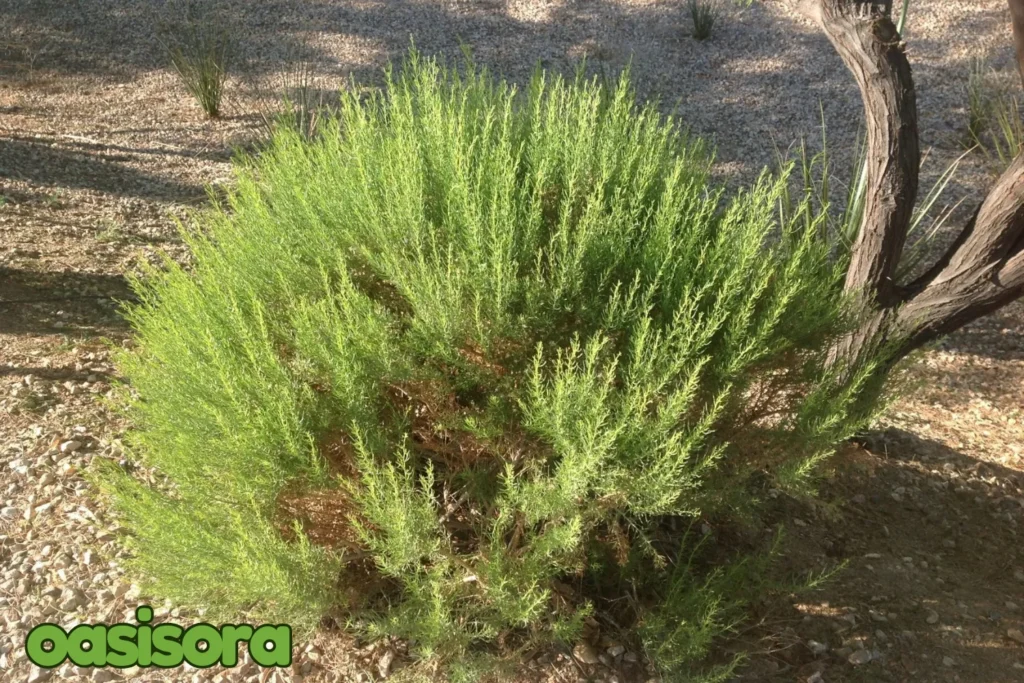
Turpentine Bush – (Ericameria laricifolia)
41. Apache Plume (Fallugia paradoxa) – Delicate white flowers and feathery seed heads.
| Native to: | Southwestern United States and North Mexico |
| USDA Zones: | 4-9 |
| Pros: | It dazzles with pale pink to white blossoms from spring to fall, followed by a dramatic winter finale of feathery pink seed heads. |
| Considerations: | Thrives in full sun, extremely drought-tolerant, and hardy to -30°F. |
Enhance your outdoor area with Apache Plume’s stunning flowers with pink and white hues!.
A tough shrub that brings in pollinators along with birds and wildlife, this shrub is both ornamental as well as practical.
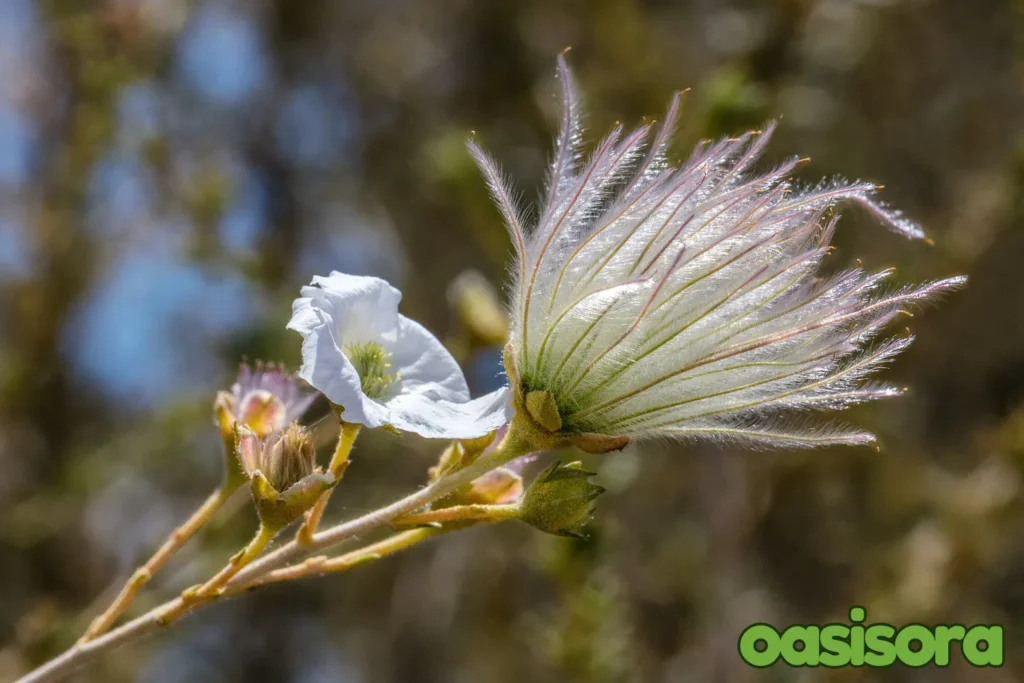
Apache Plume – (Fallugia paradoxa)
42. Feather Bush (Lysiloma watsonii) – Fern-like foliage with small, cream-colored flowers.
| Native to: | Northern Mexico, Southwestern United States |
| USDA Zones: | 9, 10, and 11 |
| Pros: | Drought-resistant, low-maintenance plant, featuring unique flowers that are too attractive to birds and other pollinators |
| Considerations: | it may require occasional pruning, is not suitable for shady areas, and may drop leaves during extreme drought. |
Feather Bush is an excellent and chic addition to create variations to your southwestern landscape.
This deciduous shrub features fern-like leaves and has about three pale creamy flowers that bloom and attract hummingbirds and some other pollinators.
This desert tree is also a real time-saver in that it gets quite big quickly and requires little water which makes it ideal for use as a hedge or screen by gardeners who have little availability of water.
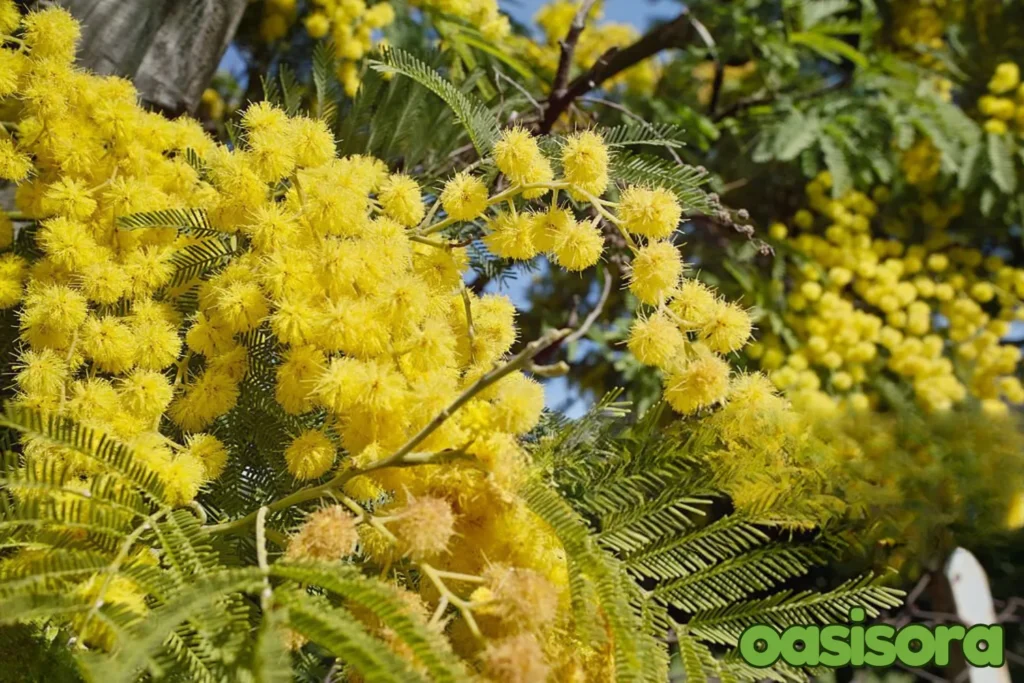
Feather Bush – (Lysiloma watsonii)
Final Words
Transform your yard into a stunning desert oasis with these 42 beautiful trees and shrubs! From colorful Paloverde flowers to majestic Joshua Trees, each plant adds its special touch.
Perfect for harsh environments, these desert stars are drought-friendly, low-maintenance, and also wildlife-loving. They make your landscape beautiful while promoting sustainability.
Great for homes or businesses, these tough trees and shrubs grow strong and healthy. So, whether you want to capture the desert chic style or save water, adding desert trees and shrubs is a smart move for a sustainable tomorrow.
Embrace the perfect mix of aesthetics and sustainability today!.
FAQs
1. What is the best tree to grow in the desert?
Paloverde and Desert Willow are the best trees to grow in the desert offering lively flowers and drought tolerance.
2. What type of tree is found in the desert?
Many kinds of trees can be found in the desert, including:
- Acacia (Wattle)
- Barrel Cactus
- Creosote Bush
- Desert Ironwood
- Joshua Tree
- Blue Palo Verde
3. What are the easiest desert plants to grow?
Cacti, Succulents, and Brittlebush are the easiest low-maintenance plants for desert landscapes as they also thrive in harsh conditions.
4. What are the most common shrubs in the desert?
Some of the most common desert shrubs are:
- Texas Sage
- Apache Plume
- Feather Bush
5. What is the best evergreen tree in the desert?
Texas Mountain Laurel and Aleppo Pine are the topmost evergreen choices for the warm climates of the desert. They offer year-round greenery and drought tolerance in USDA zones 7-11.
6. Which tree is the king of the desert?
Khejri aka Prosopis cineraria is the “King of the Desert” and also it is the State tree of Rajasthan, India.
7. What is a common desert tree?
Some common desert trees include:
- Palo Verde
- Mesquite
- Desert Willow
- Joshua Tree
- Palmetto Palm
- Desert Ironwood
- Texas Ebony
- Smoke Tree and others.
8. What is called a desert plant?
Cacti, Succulents, Texas Sage, and Brittlebush are timeless desert plants adapted to thrive in harsh conditions with minimal water and maintenance.

3 thoughts on “42 Beautiful Desert Trees and Shrubs for a Stylish Landscape”
Comments are closed.